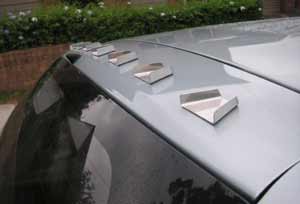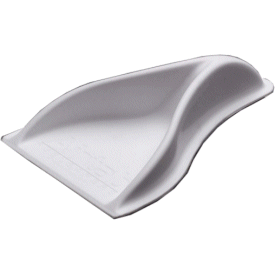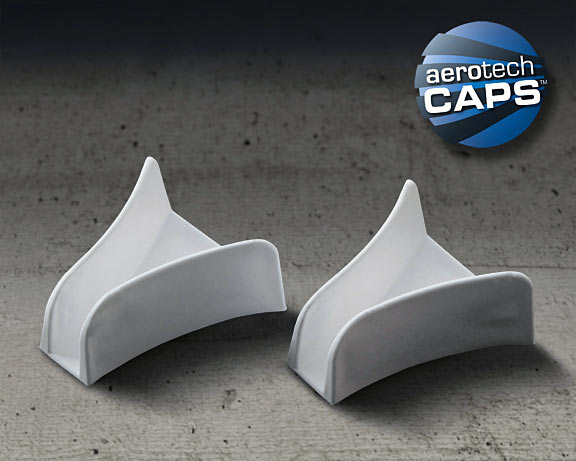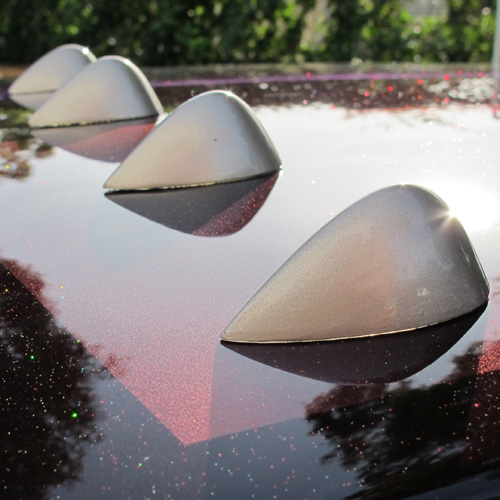A reader writes:
I was watching an awesome Honda ad featuring the ghost of Ayrton Senna and his 1989 car...
...and I noticed people arguing in the comments on Jalopnik about Doppler effect, which I think you can hear in the video as the "car" goes past the camera.
Per your previous writing about "common sense" and concepts that "slither out of people's mental grasp", can a series of speakers set up around a racetrack and playing the sound of a car actually create the same Doppler effect as the actual car did?
Ron
No, they can't.
The Doppler effect happens when a moving object emits something, in this case sound waves. When each new wave is emitted in front of the sound source, it's closer to the previous wave than it would have been if the emitter were stationary. Behind the emitter, each new wave is a bit further from its predecessor than it would be if the emitter weren't moving.
This works for light as well, hence "redshift" and "blueshift".
We don't notice redshift or blueshift in everyday life because Doppler shift is a proportional effect, and the speed of light is so high that no light-emitter that humans normally deal with moves at an appreciable fraction of lightspeed relative to us. The speed of sound, however, is relatively low (about 340 metres per second close to standard temperature and pressure), and the human ear is quite sensitive to changes in pitch. So we can easily hear this effect on the sound of a car engine...
...or horn, when that car passes us at speed.
(My favourite example of car-horn Doppler shifting, which includes a lot of moderately comprehensible cursing, is this one.)
If you set up a bunch of speakers to imitate the sound of a passing car, none of them are moving, so there will be no Doppler shift from the point of view of a stationary observer. You could create the same effect by deliberately adding pitch shifts to the sound being played so that it sounds correct from a given listening location, but that'll make it sound wrong to listeners somewhere else. Doppler changes are caused by waves being bunched up and spread out by motion, and that just doesn't happen if neither listener not sound-emitter are moving. There's nothing about the order in which speakers play sounds that change what the sounds are.
(OK, there might be some interference effects audible at various listener locations. But that wouldn't sound Doppler-y.)
There actually would be Doppler effects if you were in your own car driving around the racetrack during the ghost-of-Senna performance, though. A moving listener creates Doppler shift in exactly the same way as a moving source:
Again, though, the pitch-shifts wouldn't sound right. They'd entirely depend on your speed relative to whatever stationary speakers are sounding at a given moment.
A related concept to this is the idea of the faster-than-light laser dot.
Consider flicking the dot of a laser pointer across, say, the face of the moon. (Presume you've got a laser that's well enough collimated that it still has a small dot at that distance.)
If the dot crosses the moon in, say, a hundredth of a second, and even if you ignore its curvature the moon is about 3,400 kilometres across, then that dot is going about 340,000 kilometres per second, which is faster than light. Address for delivery of Nobel Prize in Physics will be provided on request.
Unfortunately, and to the chagrin of a great many cats, a laser dot is not a "thing". It's just where photons happen to be falling and bouncing off at any given moment. Moving a dot faster than light is indeed perfectly theoretically possible, but you might as well give two blokes each a flashlight with an accurate timer built in, have them synchronise timers and then move a thousand kilometres apart, and then turn their flashlights on and off so that one light-pulse happens a thousandth of a second before the other. Presto, now a dot has moved at a million kilometres per second, more than three times the speed of light!
Except that doesn't mean anything, because that dot of light is not a thing moving faster than light. You could fill the space between those two flashlights with a trillion more flashlights timed to give a wonderfully smooth movement of the dot, but the dot would still not be a thing travelling faster than light. A spinning lawn sprinkler may have a contact point between droplets of water and the circumference of its spray pattern that goes round and round at a quite impressive speed, but that's just where the water hits the lawn, it's not an actual separate moving object.
(By the way, smart alecks, relativistic time dilation does not mean the flashlight timers would get significantly out of sync if the flashlight-carrier on one end got to his assigned location on foot, taking weeks, and the other got to his by rocket-sled at ten thousand kilometres per hour. At 10,000km/h your clock will tick slower than that of a stationary observer, but only by a factor of 1.0000000000429. The fastest object humanity has ever made is the Helios 2 probe, at 70,220 metres per second relative to the sun; it achieved a time dilation factor all the way up at 1.000000027!)
A further extension of this idea is to say, "OK, what if I've got a stick a million kilometres long, and I hold one end of it and spin it around my head in a circle in, say, five seconds? The circumference of a circle with radius one million kilometres is 6,283,185 kilometres, and the tip of the stick it will go all the way around that circumference in five seconds, which is 1,256,637 kilometres per second. The tip of the stick is a thing and not just a dot of light, so it's really going at that speed, which is 4.2 times the speed of light, NOW can I have my Nobel prize?"
No, you still can't.
Ignoring the obvious issues regarding the construction and inertia of a million-kilometre broomstick, there is no way for one end of an object to know what's happening to the other end at faster than the speed of light. Motion of the object occurs when the molecular bonds that hold it together are stretched and pull the molecules along, and there's nothing about those molecular bonds that causes them to influence each other faster than light. Otherwise you could make an instantaneous communication system by taking your very long magic broomstick and tapping on the end of it in Morse code or something.
So even if your very long stick were made of alien indestructium with an infinite tensile strength, spinning the middle of it round and round would just cause the whole thing to start wrapping up into a spiral. You could then try cracking it like a whip if you wanted, because you're Cowboy Galactus or something, but the other end of the object would still not travel faster than light, because no "information" within the object, in this case the information regarding the location and motion of its component particles, can travel faster than light either.
This seems bizarre, but again this is because we're talking about scales far larger than those on which humans normally operate. On the very large scale, nothing is particularly solid. If planets and stars and even galaxies run into each other, the energies involved may be unimaginably large, but all of the actual objects behave pretty much as if they were made of blancmange.
(Actually, in galaxy collisions, few to no actual collisions of the objects that make up the galaxies are likely to happen, because galaxies are mostly empty space.)
If Unicron were actually the size of even a small planet, no material that even theoretically exists in the universe would be stiff enough for him to be able to transform like his car-sized distant relatives. (Well, maybe if he's made of some kind of degenerate matter and has magical technology to prevent himself from collapsing into a black hole. Once you can cancel gravity, you might as well move information faster than light, too. It never seems to take a Transformer or Decepticon much more than twenty minutes to get to anywhere in the universe, after all.)
To reward anybody who managed to get to the end of this post, the ghost-of-Senna ad sounds pretty good, but the Shell-Ferrari one from a few years ago is much better:
(I think that version's the best one on YouTube in both resolution and sound. Aspect ratio's wrong, though.)
Psycho Science is a... sort of... regular feature here. Ask me your science questions, and I'll answer them. Probably.
And then commenters will, I hope, correct at least the most obvious flaws in my answer.





